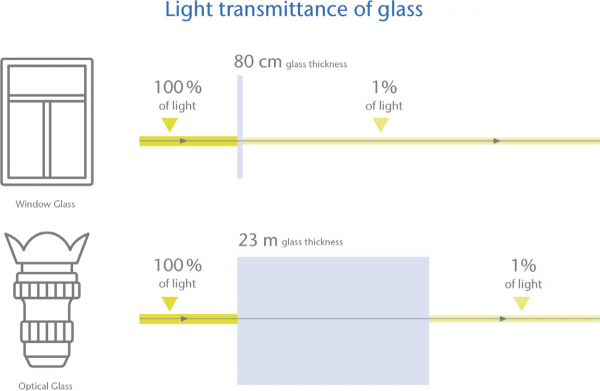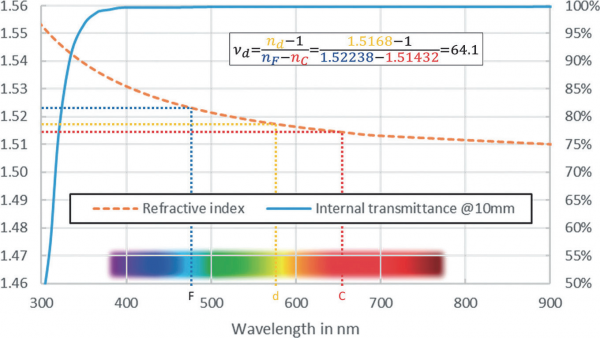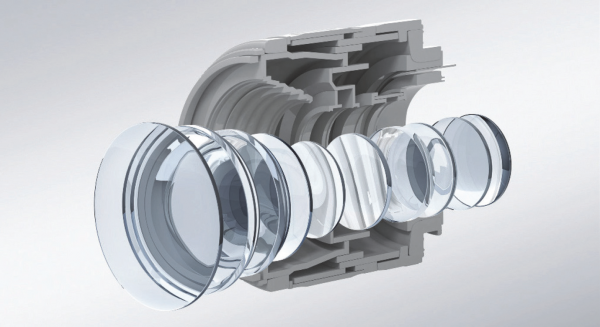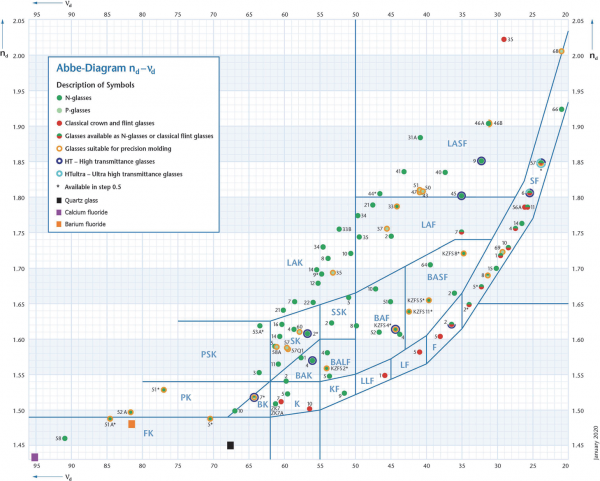What is optical glass?
Glass has many unique properties. The most obvious feature of optical glass for a human eye is the high transparency, as indicated in Figure below. Compared to window glass, the optical path in optical glass is more than 30 times longer for achieving the same transmission, which is a huge difference.

In order to achieve much higher grades of transmission than window glass, more stringent requirements are needed for the purity of the ingredients, haze level, and number of bubbles and inclusions. Figure below shows the internal transmittance over the visible spectrum and the near-infrared regime.
In contrast to the transmission, the optical position of an optical glass is not obvious for a human eye. Hereby, the refractive index at a specific wavelength and the Abbe number describing the dispersion define the optical position. The graphic in Figure below shows the decrease of the refractive index starting from the ultraviolet over the visible spectrum to the near-infrared regime. Dispersion is the name of this spectral refractive index development.
The Abbe number nd as defined in the upper box of Figure below is a measure for the dispersion. The value nd at the d-line (587.5618 nm) is typically the reference for the refractive index. These two values nd and nd define the optical position and exhibit the main distinctive features of optical glass types.

This dispersion is one of the main reasons why we need optical glasses and highly sophisticated lens systems for photonic products. If a single lens focuses a blue light ray (e.g., the F-line at 486.1327 nm) and a red light ray (e.g., the C-line at 656.2725 nm), both rays experience different deflections due to the varying refractive index. Therefore, the focus position of both colors differs. If an optical designer combines a flint and a crown glass lens in a proper way, the designer achieves that the focus of the blue and the red ray overlaps. This doublet is an achromatic system. Unfortunately, the focus position of other colors still varies. Therefore, a further chromatic correction and other aberrations require a complex multi-lens design, as depicted in Figure below.
Such lens system design relies on a broad portfolio of optical glasses that spread widely in their optical position.

This graph called nd-nd diagram, also called an Abbe diagram. This diagram maps the different optical glass types by using the refractive index and Abbe number as coordinates. The left part of the diagram corresponding to high Abbe numbers contains the crown glasses indicated with the letter “K” in the end. The right part of the diagram corresponding to low Abbe numbers contains the flint glasses as indicated with the letter “F” in the end. Besides the rough differentiation between crowns and flints, the map shows further areas of similar chemical composition, e.g., the region of barium flints with the label “BAF” or the area of lanthanum crowns with the label “LAK”. According to their position in the diagram, the glasses get their labels, e.g., F2 is located in the “F” regime. The number at the very end of the glass-type label has no further information and counts the developments in the relevant area (seldom followed by a letter indicating a new version). The prefix “N-” indicates that no lead and arsenic are contained in the glass. Then, the prefix “P-” types are special glasses that are environment friendly as well but additionally show a low transformation temperature to enable precise molding process. Finally, the suffix “HT” or “HTultra” defines special versions of the glass type with high or even ultrahigh transmittance. All explanations are valid for the optical glass manufacturer SCHOTT as a reference but are in general transferable to other manufacturers as well.

